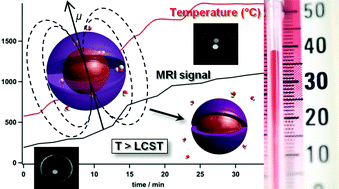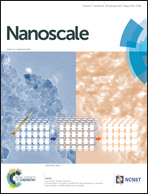Nano-thermometers with thermo-sensitive polymer grafted USPIOs behaving as positive contrast agents in low-field MRI†
Abstract
Two commercial statistical copolymers of ethylene oxide and propylene oxide, Jeffamine® M-2005 (PEO5-st-PPO37) and M-2070 (PEO46-st-PPO13), exhibiting lower critical solution temperature (LCST) in water, were grafted onto the surface of ultra-small superparamagnetic iron oxide nanoparticles (USPIOs) using silanization and amide-bond coupling reactions. The LCSTs of the polymers in solution were measured by dynamic light scattering (DLS) and nuclear magnetic resonance (NMR). In accordance with the compositions of EO vs. PO, the transition temperature was measured to be 22 ± 2 °C for M-2005 by both DLS and NMR, while the LCST was much higher, 52 ± 2 °C, for M-2070 (a second transition was also detected above 80 °C by NMR in that case, ascribed to the full dehydration of chains at the molecular level). The resulting polymer-grafted USPIOs exhibit a temperature-responsive colloidal behaviour, their surface reversibly changing from hydrophilic below LCST to hydrophobic above it. This phenomenon was utilised to design thermo-sensitive contrast agents for MRI. Transverse relaxivities (r2) of the USPIO@PEO5-st-PPO37 core–shell nanoparticles were measured at 8.25, 20, 60, and 300 MHz. Nuclear magnetic resonance dispersion (NMRD) profiles, giving longitudinal relaxivities (r1) between 0.01 and 60 MHz, were acquired at temperatures ranging from 15 to 50 °C. For all tested frequencies except 300 MHz, both r1 and r2 decrease with temperature and show an inflection point at 25 °C, near the LCST. To illustrate the interest of such polymer-coated USPIOs for MRI thermometry, sample tubes were imaged on both low-field (8.25 MHz/0.194 Tesla) and high-field (300 MHz/7.05 Tesla) MRI scanners with either T1- or T2*-weighted spin echo sequences. The positive contrast on low-field MR images and the perfect linearity of the signal with a T2*-weighted sequence over the entire temperature range 15–50 °C render these LCST polymer coated USPIOs interesting positive contrast agents, also working as “nano-thermometers”.



 Please wait while we load your content...
Please wait while we load your content...